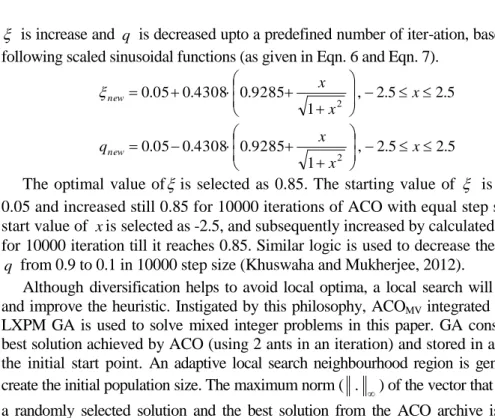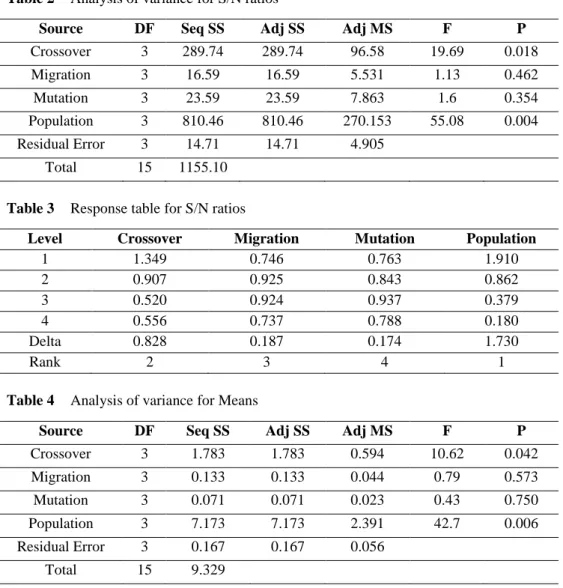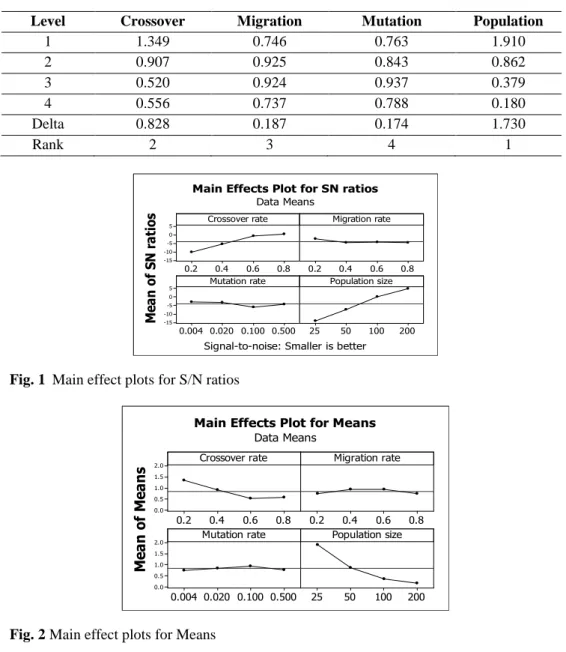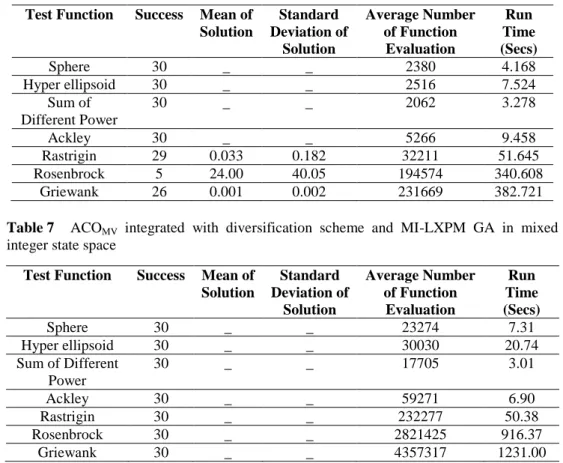A HYBRID ANT COLONY FOR MULTIRESPONSE
MIXED-INTEGER PROBLEMS
Sunil Kushwaha*, and Indrajit Mukherjee**
* Department of Mathematics, Indian Institute of Technology Bombay, Email : hiskushwaha@gmail.com
** Shailesh J. Mehta School of Management, Indian Institute of Technology Bombay, Email: indrajitmukherjee@iitb.ac.in
Abstract In this paper, a hybrid ant colony optimization (ACO) is used to solve a multiple response optimization problem with mixed-integer (MI) search space. The work reported in this paper may be clasified into three part. The first part discusses on relevant litratures and the methodology to solve multiple response optimization problem. The second part provide details on the working principal, parameter tuning of a hybrid ACO proposed for mixed integer state space. In the hybrid ACO, genetic algorithm (GA) is used for intensification of the search strategy. Standard single response (objective) test functions are selected to verify the suitability of hybrid ACO. The third part of this research work illustrates the application of the hybrid ACO in a multiple response optimization (MRO) problem. Statistical experimentation, partial least square regression, ‘maximin’ desirability function, and hybrid ACO is used to solve the MRO problem. The results confirm the suitability of the hybid ACO for a typical MI MRO problem
Paper type: Research paper Published online: 29 October 2012 Vol. 2, No. 4, pp. 317-327
ISSN 2083-4942 (Print) ISSN 2083-4950 (Online)
© 2012 Poznan University of Technology. All rights reserved.
Keywords: ant colony optimization(ACO), desirability functions, genetic algorithm(GA), mixed-integer (MI) problem, multiple response optimization(MRO)
1. INTRODUCTION
A common problem generally encountered in process industry involves optimization of multiple quality characteristics (responses) desired by the customers. The problem can be stated as determining the settings of in-process conditions (e.g. machine settings) that simultaneously optimize all the responses in presence of noise conditions (e.g. raw material composition, environmental conditions). Simultaneous optimization of multiple quality characteristics is generally referred to as ‘multiple response optimization’ (MRO) (Khuri, 1996, p. 377). In practice, MRO problem typically involves responses that are conflicting (multiobjective) in nature. In other words, optimizing a particular response will result in sacrificing the optimality of another response. Thus, there is always a trade-off between the con-flicting responses.
In this context, a graphical response surface approach, so called overlaying contour plot (Lind, Goldin, and Hickman, 1960, p. 62) is suggested to handle multiple response problems. However, the number of in-process (independent) varia-bles is practically limited to less than three due to two-dimensional solution ap-proach. Harington (1965, p. 494) first proposed a desirability function-based approach to convert a higher dimensional MRO problem to a single objective opti-mization problem using suitable transformation functions.
In his approach, the relevant desirability function is used to transform each predicted response variables to a corresponding scale-free desirability value (say,d ), which lies between zero and one (0 j dj 1). The value of d increases j as the “desirability” of the corresponding response increases. Subsequently, all the desirability values of predicted responses are transformed to a single measure, so-called ‘composite desirability’ or ‘overall desirability index ( D )’. Derringer and Suich (1980, p. 214) extended the concept of Harrington (1965, p. 494), and suggested a more generalized transformation scheme for predicted responses to desirability values. Their individual desirability transformation function varied according to its desired target of the response, viz., nominal-the-best (NTB), larger-the-better (LTB), and smaller-larger-the-better (STB).
The individual desirability function for STB type of responses is given below.
max max min min max max min ) ( 0 ) ( ) ( ) ( 1 )) ( ( 1 j j j j j t j j j j j j j y y if y y y if y y y y y y if y d X X X X X (1)
where d(yj(X))
is the desirability function of the j predicted response. th yminj and ymaxj are lower and upper bound of
th
j response, respectively. t1 is the exponential parameters that determine the desirability function form and shape.
Kim and Lin (2000, p. 311) proposed a ‘maximin’ composite desirability index function as an optimization criterion for correlated responses. Optimization technique integrated with this criterion attempts to maximize the minimum of all individual desirability values. The ‘maximin’ desirability index ( D ) is expressed as
Minimumd d d
j rMaximize , ,. . . ., r 1(1)
D 1 2
There are two broad categories of optimization search techniques which are generally recommended for MRO problems (Mukherjee, 2007, p. 103). First cate-gory is the conventional nonlinear search techniques. The second catecate-gory is unconven-tional metaheuristic search strategies. GA and ACO belong to this second category. Real coded GA (Haupt and Haupt, 2004) work on a population concept rather than single individual iterative search approach. Deep et al. (Deep, Singh, Kansal, and Mohan, 2009, p. 505) extended the concept of real-coded GA to solve typical mixed integer optimization problems. Deep et al. (Deep, Singh, Kan-sal, and Mohan, 2009, p. 505) proposed a MI-LXPM algorithm, which is an exten-sion of real-coded genetic algorithm proposed by Deep and Thakur (2007, p. 211). MI-LXPM is shown capable of solving integer and mixed integer nonlinear optimi-zation problems. In MI-LXPM, Laplace crossover and power mutation are modified and extended for integer-type decision (independent) variables. In addition, a special truncation procedure for satisfaction of integer restriction on decision variables and a ‘parameter free’ penalty approach for constraint handling are also proposed.
ACO for discrete optimization problem is proposed by Dorigo (1992). Socha and Dorigo (2008, p. 1155) proposed a variant of continuous ant colony optimization (CACO) strategy, so-called ant colony optimization in real space (ACOR). ACOR uses gaussian kernel probability density function, which is the
weighted sum of several one-dimensional gaussian functions. By this strategy, a solution archive table structure is used to store the information of independent variable(s), and its corresponding fitness value. The concept of ACOR is extended
to mixed integer state space, and so-called ACOMV (Liao, 2010/2011).
ACOMV relaxes discrete variables to continuous variable for generating new
solutions. In this paper, an intensification and diversification scheme of ACO is used, which is based on GA and intrinsic parameter functions, to solve a MRO problem with mixed integer search space.
2. HYBRID ACO STRATEGY
The starting point before developing the idea of hybrid ACO strategy is working with ACOR (Bera and Mukherjee, 2012, p. 312) to solve single response
continuous search space optimization problem. In ACOR, the pheromone information
is stored as a solution archive. A solution archive is a collection of k best solutions at given time point. In ACOR (Socha and Dorigo, 2008, p. 1155; Bera and Mukherjee,
2012, p. 312), a solution is probabilistically constructed by generating Gaussian kernel pdf function,Gi(x), for each dimension (i, where i1,...,n) of the state space. The PDFGiis constructed using only the ith coordinates of all the k solutions from the archive. The Gaussian kernel PDF Gi(x)is parameterized with three vectors of parameters, viz. is the vector of weights associated with the individual Gaussian functions, iis vector of means, and iis the vector of standard deviations. The cardinality of all these vectors is equal to the number of Gaussian functions that constitute the Gaussian kernel. Various parameters are expressed as
2 2 2 2 1 2 1 qk l l e qk } , ,... { } ,..., { 1i ik 1i ik i s s μ
k e i l i e i l k s s 1 1 where ‘q’ and ‘ ’ are heuristic parameters. When q is small, best-ranked solutions are strongly preferred, and when q is large, the probability becomes more uniform. The parameter ( and >0 ) is same for all dimensions and has an effect similar to pheromone evaporation rate in basic ACO strategy. Higher the value of , the lower the convergence speed of the algorithm. For convenience, a parameter k is used, and
k i
i
. The solutions (s ) are stored according to their ranks or quality l [depending on the value of f(sl)]. The weight () of each gaussian function is calculated using their rank value. Pheromone updates are done by adding the set of newly generated solutions to the existing solution archive, and subsequently removing the same number of worst solutions.
To improve the performance of ACO strategy for continuous and mixed integer state space, a diversification scheme is used in this paper. It works only when the solution stagnates to a specific value for a specified number of iteration. In such situation, the best solution searched so far is retained, and new k1 (k is archive size and se-lected as 100 in this study) random points are generate. To diversify the search, a low convergence rate () and a high q value is initially selected. Subse-quently, value of
(3)
(4) (5)
is increase and q is decreased upto a predefined number of iter-ation, based on the following scaled sinusoidal functions (as given in Eqn. 6 and Eqn. 7).
5 . 2 5 . 2 , 1 9285 . 0 4308 . 0 05 . 0 2 x x x new 5 . 2 5 . 2 , 1 9285 . 0 4308 . 0 05 . 0 2 x x x qnew
The optimal value ofis selected as 0.85. The starting value of is taken as 0.05 and increased still 0.85 for 10000 iterations of ACO with equal step size. The start value of xis selected as -2.5, and subsequently increased by calculated step size for 10000 iteration till it reaches 0.85. Similar logic is used to decrease the value of
q from 0.9 to 0.1 in 10000 step size (Khuswaha and Mukherjee, 2012).
Although diversification helps to avoid local optima, a local search will intensify and improve the heuristic. Instigated by this philosophy, ACOMV integrated with
MI-LXPM GA is used to solve mixed integer problems in this paper. GA considers the best solution achieved by ACO (using 2 ants in an iteration) and stored in archive as the initial start point. An adaptive local search neighbourhood region is generated to create the initial population size. The maximum norm ( . ) of the vector that separates a randomly selected solution and the best solution from the ACO archive is used to define the neighbourhood region. GA is terminated if 10000 iterations are reached or relative change in fitness functional value is less than 10-12. Other parameters of GA are selected based on Taguchi’s design of experiment trials on standard test functions.
2.1. Tuning the GA parameters
Proper selection of parameters for GA in the hybrid ACO can plays a very important role on convergence of the algorithm to optimal solution as well as on the speed of convergence. In this research work, Taguchi L16 orthogonal array design
(Mukherjee, 2007, p. 39) is used to tune the GA parameters. The goal of the simulation experiment is to determine a suitable combination of GA parameters that can result in faster convergence to global optimal for test cases. The factors and their levels selected is given in Table 1.
Table 1 Factors and Levels
Level-1 Level-2 Level-3 Level-4
Crossover rate 0.2 0.4 0.6 0.8 Migration rate 0.2 0.4 0.6 0.8 Mutation rate 0.004 0.02 0.1 0.5 Population size 25 50 100 200 (6) (7)
30 independent simulation run (replicates) for each of the 7 continuous test functions, viz. spheroid, hyper ellipsoid, difference of powers, Ackley, Rastrigin, Rosenbrock, Griewank (Molga and Smutnicki, 2005) were used for analysis. 10 dimensions continuous optimization problem with 4 parameters at 4 level is selected in the Taguchi’s L16 experimental setup. To analyze the Taguchi’s design,
different type of input test functions are introduced as noise for any row of experimentation matrix. As each of the chosen test function are ‘smaller-the-better(STB)’ type, appropiate Signal-to-Noise (S/N) ratios was selected. The ana-lysis of variance (ANOVA) tables and response tables for S/N ratio and mean on linear models using Taguchi’s experiment is provided in Tables 2 to Table 5.
Table 2 Analysis of variance for S/N ratios
Source DF Seq SS Adj SS Adj MS F P
Crossover 3 289.74 289.74 96.58 19.69 0.018 Migration 3 16.59 16.59 5.531 1.13 0.462 Mutation 3 23.59 23.59 7.863 1.6 0.354 Population 3 810.46 810.46 270.153 55.08 0.004 Residual Error 3 14.71 14.71 4.905 Total 15 1155.10
Table 3 Response table for S/N ratios
Level Crossover Migration Mutation Population
1 1.349 0.746 0.763 1.910 2 0.907 0.925 0.843 0.862 3 0.520 0.924 0.937 0.379 4 0.556 0.737 0.788 0.180 Delta 0.828 0.187 0.174 1.730 Rank 2 3 4 1
Table 4 Analysis of variance for Means
Source DF Seq SS Adj SS Adj MS F P
Crossover 3 1.783 1.783 0.594 10.62 0.042 Migration 3 0.133 0.133 0.044 0.79 0.573 Mutation 3 0.071 0.071 0.023 0.43 0.750 Population 3 7.173 7.173 2.391 42.7 0.006 Residual Error 3 0.167 0.167 0.056 Total 15 9.329
Table 5 Response table for Means
Level Crossover Migration Mutation Population
1 1.349 0.746 0.763 1.910 2 0.907 0.925 0.843 0.862 3 0.520 0.924 0.937 0.379 4 0.556 0.737 0.788 0.180 Delta 0.828 0.187 0.174 1.730 Rank 2 3 4 1 0.8 0.6 0.4 0.2 5 0 -5 -10 -15 0.8 0.6 0.4 0.2 0.500 0.100 0.020 0.004 5 0 -5 -10 -15 200 100 50 25 Crossover rate M ea n of S N r at io s Migration rate
Mutation rate Population size
Main Effects Plot for SN ratios
Data Means
Signal-to-noise: Smaller is better Fig. 1 Main effect plots for S/N ratios
0.8 0.6 0.4 0.2 2.0 1.5 1.0 0.5 0.0 0.8 0.6 0.4 0.2 0.500 0.100 0.020 0.004 2.0 1.5 1.0 0.5 0.0 200 100 50 25 Crossover rate M ea n o f M ea n s Migration rate
Mutation rate Population size
Main Effects Plot for Means
Data Means
Fig. 2 Main effect plots for Means
The main effect plots for means and S/N ratio is shown in Fig. 1 and Fig. 2, respectively. As the goal is to maxize the S/N ratios and minimize means, seeing all the tables and figures above, the best parameter setting for GA was selected as (i) crossover rate as 0.8, (ii) migration rate as 0.2, (iii) mutation rate as 0.004, and (iv) population size as 200.These final setting was also selected in the mixed integer and multiple response optimization problems.
2.2. Results and Discussion
All the computational runs reported are performed on specific desktop personal computer (PC) using matlab software. The PC configuration is2.80 GHz intel dual core processor with 1.98 GB RAM. The results of 30 computational run for each test function in mixed integer problems, using ACOMV with only diversification
scheme, and ACOMV integrated with MI-LXPM and diversification scheme is
provided in Table 6 and Table 7, respectively. Success in a run is achieved in any particular run for a test case, if the difference between global optimum and solution obtained by a metaheuristic is less than 10-4.
Comparing the results of Table 6 and Table7, it is evident that integrating GA with ACO improves the solution quality and also the success rate. Instigated by the above results, a multiple response optimization case is selected for investigating the performance of hybrid ACO strategy.
Table 6 ACOMV with diversification scheme in mixed integer state space Test Function Success Mean of
Solution Standard Deviation of Solution Average Number of Function Evaluation Run Time (Secs) Sphere 30 _ _ 2380 4.168 Hyper ellipsoid 30 _ _ 2516 7.524 Sum of Different Power 30 _ _ 2062 3.278 Ackley 30 _ _ 5266 9.458 Rastrigin 29 0.033 0.182 32211 51.645 Rosenbrock 5 24.00 40.05 194574 340.608 Griewank 26 0.001 0.002 231669 382.721
Table 7 ACOMV integrated with diversification scheme and MI-LXPM GA in mixed integer state space
Test Function Success Mean of Solution Standard Deviation of Solution Average Number of Function Evaluation Run Time (Secs) Sphere 30 _ _ 23274 7.31 Hyper ellipsoid 30 _ _ 30030 20.74 Sum of Different Power 30 _ _ 17705 3.01 Ackley 30 _ _ 59271 6.90 Rastrigin 30 _ _ 232277 50.38 Rosenbrock 30 _ _ 2821425 916.37 Griewank 30 _ _ 4357317 1231.00
3. A MULTIPLE RESPONSE OPTIMIZATION CASE
A full factorial design of experiment data on a wear and friction tester machine is used for analysis. In the machine, the tester operates with a pin positioned perpendicular to a flat circular hardened steel disc. 72 experiments were conducted with 3 independent variables (two are ordinal discrete and one is continuous variable). The variables are materials (aluminum and brass,x1), load (4 unit le-vels,x2), and linear velocity (3 unit levels,x3). The responses are coefficient of friction under sliding contact (y1), frictional force (y2), wear rate (y3), and surface temperature (y4). The objective of experiment is to determine the best set-tings of control variables that minimize all the response values. A partial least square regression model (Rosipal and Kramer, 2006, p. 34) is used to develop the response surface. SAS statistical software is used to estimate the regression coefficient. The overall multiple response problem is formulated as,
1,0,
3,4,5,6,7
,1 2 . . ) ( min 3 2 1 3 3 2 2 1 1 0 x x x t s x x x y f i i i i iTable 8 Best setting using Hybrid ACO Optimization Technique Metal Load (Kgf) Linear velocity (m/s) Maximum Composite Desirability
Hybrid ACO Brass 4 1.2931 0.4275
Desirability functions (with t1 as 1) are used to reduce the dimensionality and
convert the problem to a single objective optimization case. 30 successful computational run achieved the same best setting as given in Table 8. The target values of all responses are set to zeros (STB type), and the overall desirability value (D) achieved is 0.4275.
4. CONCLUSION
This paper illustrates the suitability of a hybrid ACO strategy for MRO prob-lems with mixed integer search space. GA-based local search was integrated in the hybrid ACO to improve the solution quality. The search strategy was verified using single and multiple response optimization problems. Fine tuning of the intrinsic parameter of GA is based on Taguchi’s experimental concept of robust design. However, scope exists to test and improve the hybrid strategy in complex real life industrial mixed integer MRO problems.
REFERENCES
Bera, S. and Mukherjee, I. (2012) “An Ellipsoidal Distance-based Search Strategy of Ants for Nonlinear Single and Multiple Response Optimization Problems”, [in:] European Journal of Operations Research, vol. 223, pp. 321-332, 2012.
Deep, K., Singh, K. P., Kansal, M. L., & Mohan, C., (2009), “A real coded genetic algorithm for solving integer and mixed integer optimization problems”. [in:] Applied Mathematics and Computation, Vol. 212, pp. 505–518.
Deep, K., & Thakur, M. (2007), “A new mutation operator for real coded genetic algorithms”, [in:] Applied Mathematics and Computation, Vol. 193, pp. 211–230. Derringer, G. , Suich, R., (1980), "Simultaneous optimization of several response
variables”, [in:] Journal of Quality Technology, Vol. 12, No.4, pp. 214-219 Dorigo, M.(1992), Optimization, Learning and Natural Algorithms (in Italian). Ph.D. thesis,
ipartimento di Elettronica, Politecnico di Milano, Italy.
Harrington, E. C. Jr., (1965), "The desirability function”. [in:] Industrial Quality Control, Vol. 21, No.10, pp. 494–498.
Haupt, R. L., Haupt, S. E., (2004), Practical genetic algorithms. 2nd ed. New York: John Wiley & Sons, Inc.
Khuri, A. I., (1996), Ghosh, S., & Rao, C. R. (Eds.), "Multiresponse surface methodology”, Handbook of Statistics: Design and Analysis of Experiments, 13, pp. 377–406, North Holland: Elsevier Science.
Kim, K., and Lin, D., (2000), "Simultaneous optimization of mechanical properties of steel by maximizing exponential desirability functions”. [in:] Applied Statistics: Journal of the Royal Statistical Society, Series C, Vol. 49, No. 3, pp. 311-325.
Kushwaha, S. and Mukherjee, I. (2012) A Hybrid GA-based Ant Colony Strategy for Continuous Correlated Multiple Response Optimization Problem, [in:] IEEE Colloquium on Humanities, Science & Engineering Research, Malaysia 2012, In Press. Liao, T., (2010/2011), Improved ant colony optimization algorithms for continuous and
mixed discrete-continuous optimization problems. Supervisors: Dorigo, M. and Stützle, T: [in:] Report d’avancement de recherche Année , IRDIA.
Lind, E. E., Goldin, J., & Hickman J. B., (1960), "Fitting yield and cost response surfaces”, [in:] Chemical Engineering Progress, Vol. 56, No.11, pp. 62–68.
Molga, M., & Smutnicki, C., (2005), “Test functions for optimization needs”, available [in:] http://www.zsd.ict.pwr.wroc.pl/files/docs/functions.pdf.
Mukherjee, I., (2007), Modeling and Optimization of Abrasive Metal Cutting Processes. PhD Thesis, Indian Institute of Technology (IIT) Kharagpur, India.
Rosipal, R., & Krämer, N. (2006), Overview and Recent Advances in Partial Least Squares. In: Saunders, C. et al. (Eds.), LNCS, Vol. 3940, pp. 34–51.
Socha, K., Dorigo, M., (2008), “Ant colony optimization for continuous domains”. [in:] European Journal of Operations Research, Vol.185, pp. 1155-1173.
BIOGRAPHICAL NOTES
Mr Sunil Kushwaha is a statistician in the Cytel Statistical Software and Services,
since June 2012. He did his masters in Applied Statistics and Informatics (ASI) from Department of Mathematics, IIT Bombay. His research focuses on
meta-heuristics optimization, multiple response optimization, and statistical computing using nonparametric methods.
Dr Indrajit Mukherjee is an assistant professor in Shailesh J. Mehta School of
Management IIT Bombay, India. He teaches operations management and quality management. His research interests are multiple response optimization, quality engineering, quality management, applied statistics and operations research. His paper appear in numerous journals including european journal of operations research, applied soft computing, computers and industrial engineering.



